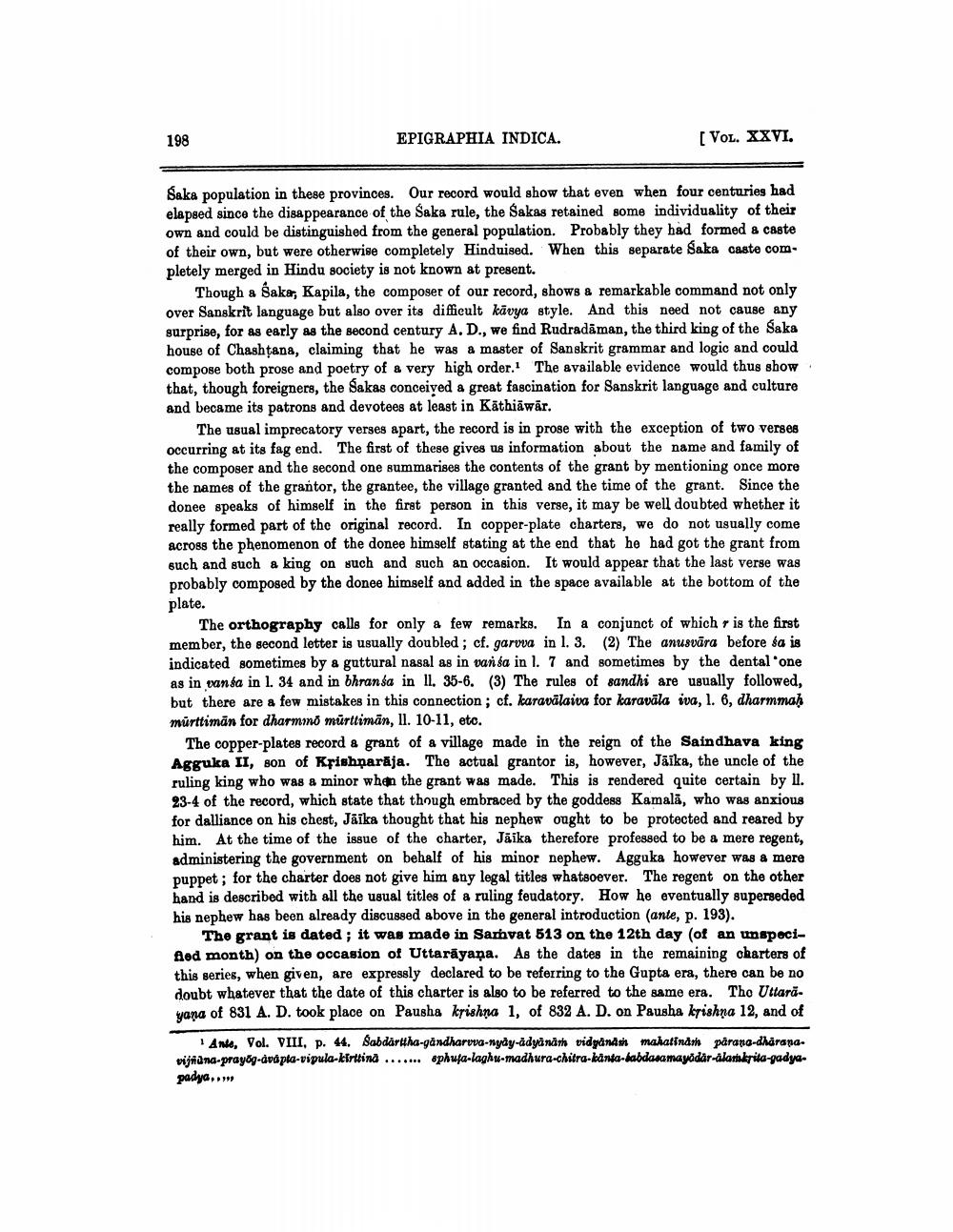________________
198
EPIGRAPHIA INDICA.
[VOL. XXVI.
Saka population in these provinces. Our record would show that even when four centuries had elapsed since the disappearance of the Saka rule, the Sakas retained some individuality of their own and could be distinguished from the general population. Probably they had formed a caste of their own, but were otherwise completely Hinduised. When this separate Saka caste completely merged in Hindu society is not known at present.
Though a Ŝaka, Kapila, the composer of our record, shows a remarkable command not only over Sanskrit language but also over its difficult kävya style. And this need not cause any surprise, for as early as the second century A. D., we find Rudradaman, the third king of the Saka house of Chashtana, claiming that he was a master of Sanskrit grammar and logic and could compose both prose and poetry of a very high order. The available evidence would thus show that, though foreigners, the Sakas conceived a great fascination for Sanskrit language and culture and became its patrons and devotees at least in Käthiäāwār.
The usual imprecatory verses apart, the record is in prose with the exception of two verses occurring at its fag end. The first of these gives us information about the name and family of the composer and the second one summarises the contents of the grant by mentioning once more the names of the grantor, the grantee, the village granted and the time of the grant. Since the donee speaks of himself in the first person in this verse, it may be well doubted whether it really formed part of the original record. In copper-plate charters, we do not usually come across the phenomenon of the donee himself stating at the end that he had got the grant from such and such a king on such and such an occasion. It would appear that the last verse was probably composed by the donee himself and added in the space available at the bottom of the plate.
The orthography calls for only a few remarks. In a conjunct of which r is the first member, the second letter is usually doubled; cf. garova in 1. 3. (2) The anusvara before sa is indicated sometimes by a guttural nasal as in vansa in 1. 7 and sometimes by the dental 'one as in vansa in l. 34 and in bhransa in l. 35-6. (3) The rules of sandhi are usually followed, but there are a few mistakes in this connection; cf. karavalaiva for karavāla iva, 1. 6, dharmmaḥ murttimän for dharmmo murttimän, 11. 10-11, etc.
The copper-plates record a grant of a village made in the reign of the Saindhava king Agguka II, son of Krishnaraja. The actual grantor is, however, Jaika, the uncle of the ruling king who was a minor when the grant was made. This is rendered quite certain by ll. 23-4 of the record, which state that though embraced by the goddess Kamala, who was anxious for dalliance on his chest, Jaika thought that his nephew ought to be protected and reared by him. At the time of the issue of the charter, Jaika therefore professed to be a mere regent, administering the government on behalf of his minor nephew. Agguka however was a mere puppet; for the charter does not give him any legal titles whatsoever. The regent on the other hand is described with all the usual titles of a ruling feudatory. How he eventually superseded his nephew has been already discussed above in the general introduction (ante, p. 193).
The grant is dated; it was made in Samvat 513 on the 12th day (of an unspecified month) on the occasion of Uttarayana. As the dates in the remaining charters of this series, when given, are expressly declared to be referring to the Gupta era, there can be no doubt whatever that the date of this charter is also to be referred to the same era. The Uttarayana of 831 A. D. took place on Pausha krishna 1, of 832 A. D. on Pausha krishna 12, and of
Ante, Vol. VIII, p. 44. Sabdarttha-gandharvva-nyay-ädyānām vidgānāṁ mahatinam parana-dharanavijñāna-prayog-dvápta-vipula-kirttinä....... ephuja-laghu-madhura-chitra-kanta-labdasamayödär-alamkrita-gadya
padya.....




